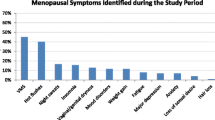Abstract
Objective
To evaluate the long-term trends in the HRT following the results of the WHI, which were made public in July 2002.
Study design
An observational cohort study was performed from prescription data of estrogen containing products ordered from Tripler Army Medical Center between July 1999 and July 2005. We used automated pharmacy data to identify all estrogen products dispensed to active duty soldiers, dependent wives, and retirees during the study period. Differences in prescription rate were compared between groups using a Student’s t-test.
Results
A total of 71,592 prescriptions were written for HRT. Prescriptions decreased from 1,272/month at the start of the study to 493/month at the conclusion of the study. Prior to July 2002 OBGYNs were the first to decrease their prescribing rate of estrogen, and this decrease was greater than other specialties analyzed. The frequency of HRT prescriptions decreased after July 2002 while the percentage of patients who filled HRT prescriptions increased from 68 to 72%.
Conclusions
We have found a significant decrease in prescriptions after release of the WHI initiative results. With this decrease in prescribing rate of HRT we found that a greater percentage of women actually filled their prescriptions perhaps indicating greater certainty in their choice.




Similar content being viewed by others
Abbreviations
- WHI:
-
Women’s health initiative
- HRT:
-
Hormone replacement therapy
- OB/GYN:
-
Obstetrician gynecologist
References
Anderson GL, Judd HL, Kaunitz AM, Barad DH, Beresford SA, Pettinger M, et al (2003) Effects of estrogen plus progestin on gynecologic cancers and associated diagnostic procedures: the Women’s health initiative randomized trial. JAMA 290(13):1739–1748. 1538-3598, (Electronic), Notes: CORPORATE NAME: Women’s Health Initiative Investigators
Rossouw JE, Anderson GL, Prentice RL, LaCroix AZ, Kooperberg C, Stefanick ML et al (2002) Risks and benefits of estrogen plus progestin in healthy postmenopausal women: principal results from the Women’s Health Initiative randomized controlled trial. JAMA 288:321–333 Notes: CORPORATE NAME: Writing Group for the Women's Health Initiative Investigators
Anderson GL, Limacher M, Assaf AR, Bassford T, Beresford SA, Black H et al (2004) Effects of conjugated equine estrogen in postmenopausal women with hysterectomy: the women’s health initiative randomized controlled trial. JAMA 291(14):1701–1712. 1538-3598, (Electronic) Notes: CORPORATE NAME: Women's Health Initiative Steering Committee
Buist DS, Newton KM, Miglioretti DL, Beverly K, Connelly MT, Andrade S et al (2004) Hormone therapy prescribing patterns in the United States. Obstet Gynecol 104(5 Pt 1):1042–1050. 0029-7844 (Print)
Bilgrami I, Blower K, Feng J, Stefanko G, Tan E (2004) Changes in the use of hormone replacement therapy in New Zealand following the publication of the Women’s Health Initiative trial. N Z Med J 117(1206):U1175. 1175-8716 (Electronic)
Lawton B, Rose S, McLeod D, Dowell A (2003) Changes in use of hormone replacement therapy after the report from the women’s health initiative: cross sectional survey of users. BMJ 327(7419):845–846. 1468-5833 (Electronic)
Keating NL, Cleary PD, Rossi AS, Zaslavsky AM, Ayanian JZ (1999) Use of hormone replacement therapy by postmenopausal women in the United States. Ann Intern Med 130:545–553
Weiss NS, Ure CL, Ballard JH, Williams AR, Daling JR (1980) Decreased risk of fractures of the hip and lower forearm with postmenopausal use of estrogen. N Engl J Med 303:1195–1198
Leung KY, Ling M, Tang GW (2005) Use of hormone replacement therapy in the Hong Kong public health sector after the women’s health initiative trial. Maturitas 52(3–4):277–285. Epub 2005 Jun 9. 0378-5122 (Print)
Hersh AL, Stefanick ML, Stafford RS (2004) National use of postmenopausal hormone therapy: annual trends and response to recent evidence. JAMA 291:(1)47–53. 1538-3598 (Electronic)
Schmittdiel J, Selby JV, Grumbach K, Quesenberry CP Jr (1999) Women’s provider preferences for basic gynecology care in a large health maintenance organization. J Womens Health Gend Based Med 8:825–833
Ettinger B, Grady D, Tosteson AN, Pressman A, Macer JL (2003) Effect of the women’s health initiative on women’s decisions to discontinue postmenopausal hormone therapy. Obstet Gynecol 102:1225–1232
Farquhar CM, Kofa E, Power ML, Zinberg S, Schulkin J (2002) Clinical practice guidelines as educational tools for obstetrician-gynecologists. J Reprod Med 47:897–902
Author information
Authors and Affiliations
Corresponding author
Additional information
The views expressed herein are those of the authors and do not reflect the official policy or opinion of the Department of Defense or the United States Army or Navy.
Rights and permissions
About this article
Cite this article
Parente, L., Uyehara, C., Larsen, W. et al. Long-term impact of the women’s health initiative on HRT. Arch Gynecol Obstet 277, 219–224 (2008). https://doi.org/10.1007/s00404-007-0442-1
Received:
Accepted:
Published:
Issue Date:
DOI: https://doi.org/10.1007/s00404-007-0442-1




